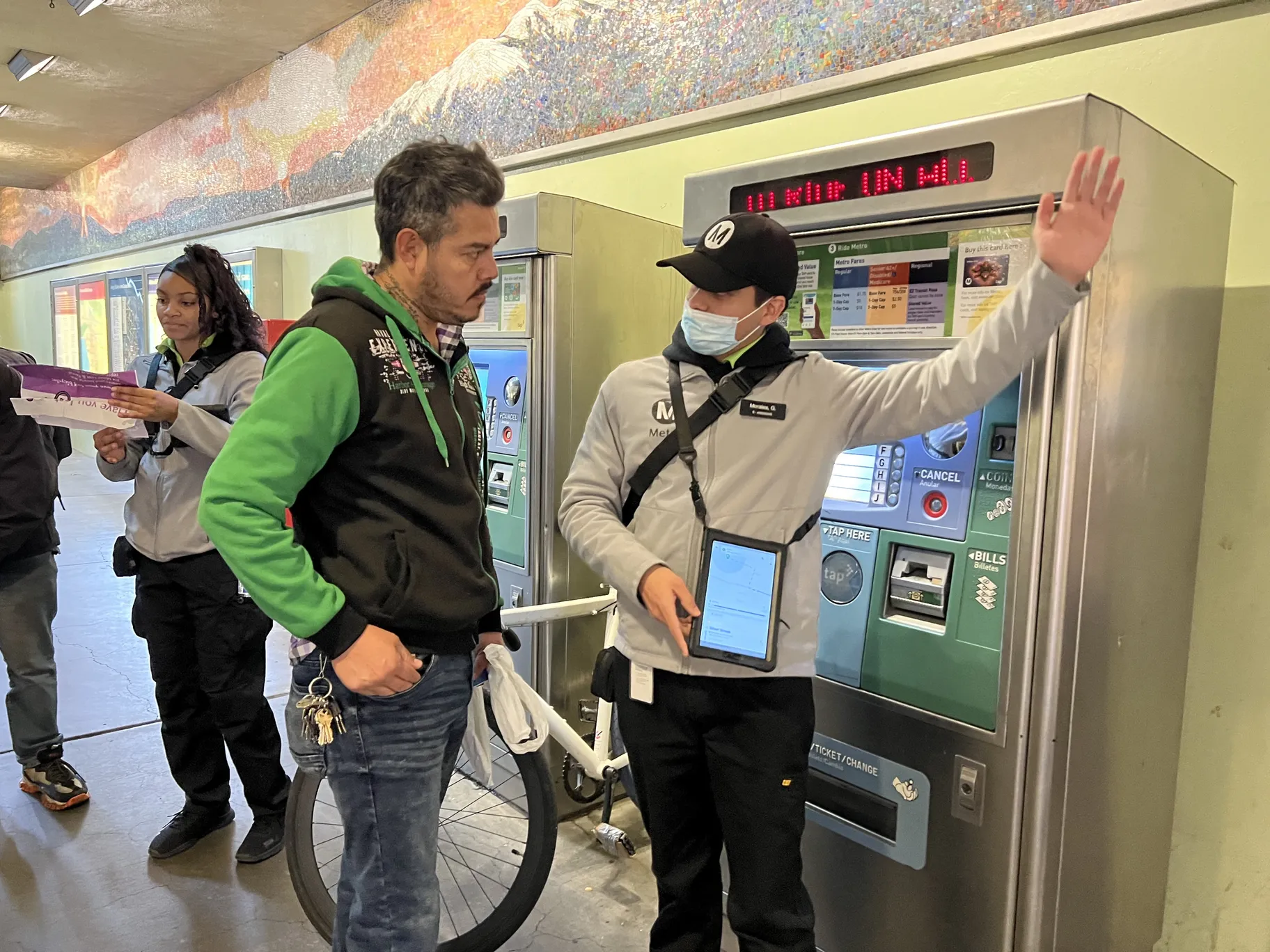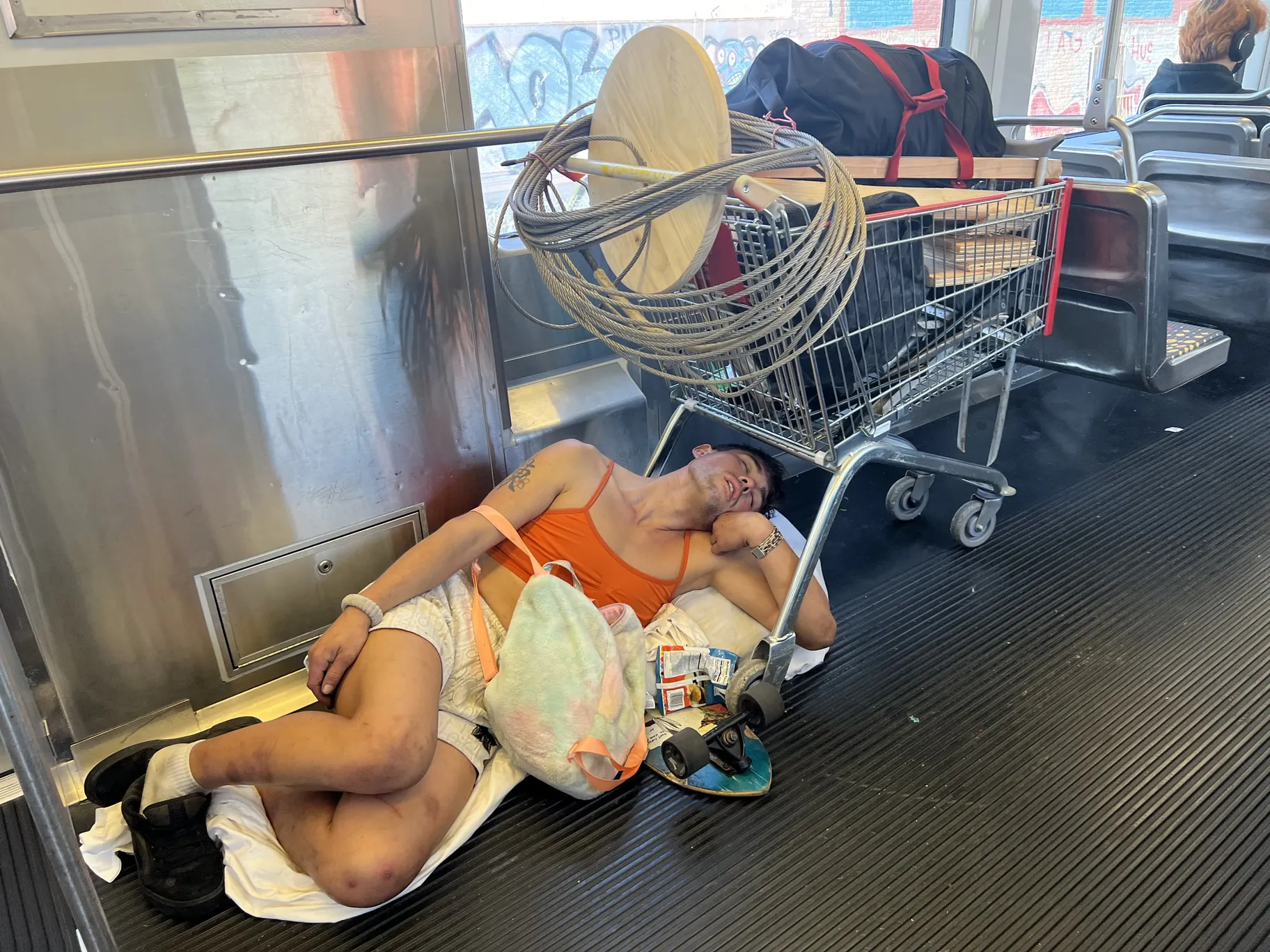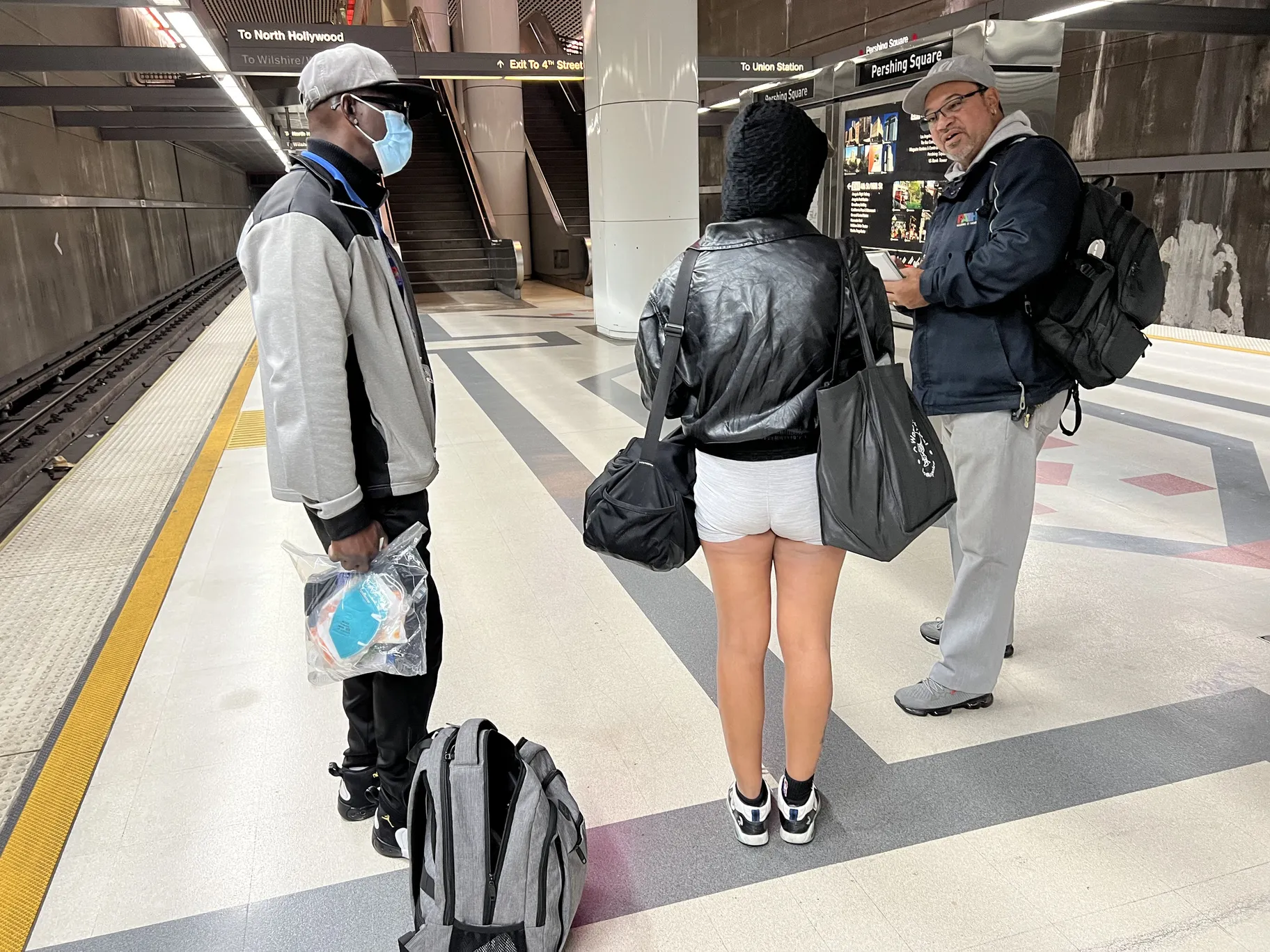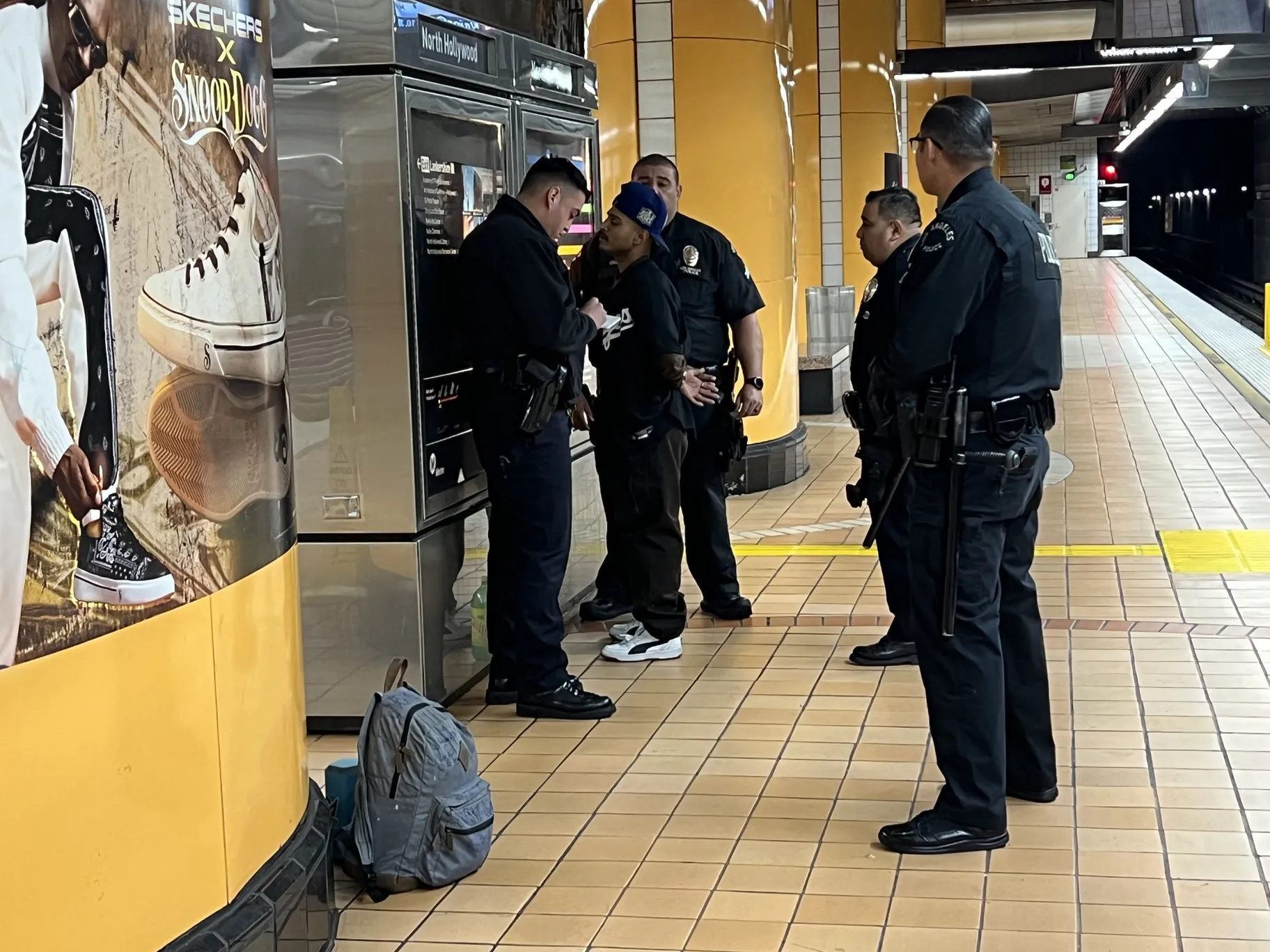During the worst months of the COVID pandemic, ridership on Los Angeles mass transit plummeted. But in recent months, riders have come back, nearly to pre-pandemic levels. And Metro, LA County’s transportation authority, wants to keep that momentum going.
One of their big obstacles? How public transportation in Los Angeles is perceived. In public forums and on social media, Metro hears from riders who complain about quality of service, and safety and policing worries. Then there’s the homeless population on the system, who use trains, buses and transit stations as temporary shelters.
In response, the agency has invested heavily in improving the ridership experience. To see how Metro is rethinking public transit, just go to a busy light rail or subway station, and look for one of Metro’s new transit ambassadors.
Started in late 2022, the Ambassadors program consists of some 350 people dressed in clearly identifiable neon-colored polo shirts and windbreakers, stationed at Metro transit stops where they offer riders assistance. That’s everything from helping them buy TAP transit cards to offering advice on to how best make transit connections so they can get to their destinations faster.

Metro Ambassador Gilberto Morales helps a passenger with navigating the public transit system at LA’s Union Station. Photo: Saul Gonzalez.
Ambassador Aryna Moore says she hears from grateful riders daily.
“People come up to us and they tell us how much they appreciate us,” says Moore. “They tell us how much we made their day better, how much we help them.”
Along with offering a kind of mass transit concierge service, Metro ambassadors also play a public safety role, reporting acts of vandalism at stations and carrying Narcan to counter drug-overdoses. And just the ambassadors’ friendly presence at stations is supposed to make riders feel safer about taking public transportation.
“Sometimes, some people will come and ask if they can stand next to us just to feel like they have some type of protection,” says Moore.
A recent Metro survey reported more than 60% of riders say they feel more secure because of the presence of ambassadors on the transit system.
Of course, there are people and problems on LA’s buses, trains and subways that go beyond what Metro’s ambassadors are trained to do, namely the large number of riders who are homeless, many of whom are also dealing with addiction and mental health issues.

Homeless outreach workers look for telltale signs that passengers are using trains for shelter, such as this rider on a light-rail train between Azusa and Los Angeles. Photo: Saul Gonzalez.
To help the unhoused, Metro has turned to teams of homeless outreach workers who are under contract to the transit agency.
One of those workers, Julian Turner, spends his days with a partner moving from one transit station to another, looking for unhoused people who need help. Turner can offer them referrals to homeless services and items like personal hygiene kits.

Metro homeless outreach worker Julian Turner (right) and his partner (left) speak to unhoused individuals at Metro’s Pershing Square subway station. Photo: Saul Gonzalez.
Turner says a big challenge working with the unhoused people riding public transportation, compared to those in encampments, is their mobility. It’s hard to do follow-ups with people if they’re constantly moving from train to train or station to station.
“The one essential thing that they got to have is a phone,” says Turner. “The reason why is communication. I can communicate with them from wherever they are.The ones who ride these rails, these trains, they know the train system as well as we do. They’ll sleep here tonight if it’s safe, tomorrow they’ll be at the beach.”
At the Pershing Square subway station, Turner meets Mary Lou, who doesn’t want her last name used because she’s been a victim of domestic violence.
“I do spend a lot of my time on the subway,” Mary Lou says, because it makes her feel a little safer. When Mary Lou tells Turner she’s hungry, he leads her out of the station to buy her slices of pizza and a cup of coffee. He also gives her a small bag of toiletries.
Mary Lou says she appreciates the small act of kindness: “Three days ago, I was in so much depression that I said to myself, ‘Okay, I'm just going to end it. I'm just done,’” she says. “Today, there was hope again.”
But Turner acknowledges there are limits to how much help Metro’s homeless outreach teams can give people like Mary Lou, especially when it comes to housing.
“We need open beds. We need places to put these people,” he says. “But if you tell them, ‘Okay I have to make a referral for you,’ and then there’s no bed, and then I have to come back and tell them that, they are going to be disturbed. And then the next time you see them, they’re going to say, ‘Oh man, you lied to me.’”
Then there’s the continuing problem of crime and drugs on the Metro system. In just one three-month period last year, more than 20 people died in and around Metro facilities, many of them from drug overdoses.
But Metro officials say crime numbers have dramatically fallen in recent months because of stepped up policing.
Regular Metro rider Michael Washington says he feels safer now than a few months ago, but wishes more police rode trains and buses instead of focusing on patrolling stations and platforms.
“Just to have somebody in a uniform that is on the train,” he says, “because that's when stuff kicks off.”
Policing on Metro’s transit system is mostly handled through contracts with local law enforcement agencies, like the Los Angeles County Sheriff Department and the LAPD, but Metro is studying the idea of creating its own transit police force.
“I think it would give us the opportunity to have more accountability, to have more transparency,” says Gina Osborne, the chief safety and security officer for Metro. “It would allow us to have the training that Metro believes to be important for these officers.”

LAPD officers question a suspect on a subway platform in North Hollywood. It’s one of several stations, including MacArthur Park and Pershing Square, that are patrolled more heavily by law enforcement because of reported criminal activity. Photo: Saul Gonzalez.
Some civil rights and transportation experts question the need for a whole new transit police force.
UCLA transportation expert Madeline Brozen says Metro should invest in expanding its new outreach programs instead.
Brozen also says better and faster service that attracts more riders is the real key to safety on public transit.
“One of the most important things we can do to make people feel safe on the system is to get more people to ride it,” says Brozen. “That’s the No. 1 thing people are looking for is fast and reliable service. And so once you hit those most important things, then you see people coming back. And then that kind of keeps rebounding in a virtuous way.”
